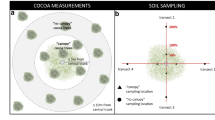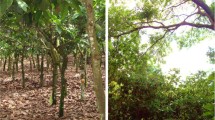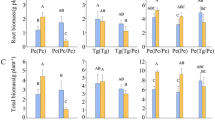Abstract
Intercropping is often promoted for effective mutualism between species, thus compensating for external inputs. However, for optimal farm design resulting in superior production and nutrition, an accurate assessment of plant inter- and intra-specific competition is required. In predominant shade tree-cocoa (Theobroma cacao) systems, inconclusive evidence remains on species interactions, limitations to resource availability and subsequent growth and nutritional response, particularly in early growth. We examined cocoa biomass and foliar nutrition as well as nutrient supply through rates of decomposition and N mineralization after 1-year growth. Our approach employed fertilization and mixed planting treatments in an additive design of cocoa in monoculture (control), under artificial shade, and intercropped under two separate shade species (Terminalia superba and Newbouldia laevis). Intercropping had no effect on cocoa biomass production in comparison to monoculture cocoa. However, artificial shading stimulated foliage and root production both with and without fertilization, suggesting strong effects of light regulation on growth in the absence of belowground competition. Nutritionally, intercropping suppressed K uptake in cocoa foliage as K concentration was reduced by 20–25%, signifying dilution of this nutrient, presumably due to interspecific competition for mobile elements. Foliar N content under N. laevis was raised, where N concentration kept up with growth under this intercropped species. Intercropping also delayed decomposition rates, suggesting slower but sustained release of available nutrients into the topsoil. Cocoa under artificial shade, both with and without fertilization, exhibited the greatest nutrient responses as compared to unfertilized monoculture cocoa, where P uptake was stimulated most (175 and 112%), followed by K (69 and 71%), and then N (54 and 42%). Intercropping with shade trees failed to increase cocoa biomass, however, nutrient uptake was sustained for N and P, suggesting low interspecific competition. When fertilizers are undesirable or unavailable, intercropping of appropriately selected shade trees will not competitively suppress early growth of cocoa but will improve light regulation and nutritional status of cocoa saplings.



Similar content being viewed by others
References
Allen SE (1974) Chemical analysis of ecological materials. Wiley, New York
Amanor KS (1994) The new frontier; Farmers response to land degradation. A West African study. UNRISD, London, England
Anderson JM, Swift MJ (1983) Decomposition in tropical forests. In: Sutton SL, Whitmore TC, Chadwick AC (eds) Tropical rain forests: ecology and management. Special publication 2. British Ecological Society, Blackwell Scientific, Oxford, England
Anderson JM, Ingram JSI (1993) Tropical soil biology and fertility: a handbook of methods, 2nd ed. CAB International, Wallingford, Oxford, UK
Beer J, Muschler R, Kass D, Somarriba E (1998) Shade management in coffee and cacao plantations. Agrofor Syst 38:139–164
Cunningham RK, Arnold PW (1962) The shade and fertilizer requirements of cacao (Theobroma cacao) in Ghana. J Sci Food Agric 13:213–221
Duguma B, Gockowski J, Bakala J (2001) Smallholder Cacao (Theobroma cacao Linn.) cultivation in agroforestry systems of West and Central Africa: challenges and opportunities. Agrofor Syst 51:177–188
Fassbender HW, Beer J, Heuveldop J, Imback A, Enriquez G, Bonnemann A (1991) Ten year balances of organic matter and nutrients in agroforestry systems at CATIE, Costa Rica. For Ecol Manag 45:173–183
Gap Light Analyzer, Version 2 (1999) Simon Fraser University, British Columbia, Canada and the Institute of Ecosystem Studies, New York, USA
Galyuon IKA, McDavid FB, Lopez FB, Spence JA (1996) The effect of irradiance level on cocoa (Theobroma cacao) L.: 1. Growth and leaf adaptations. Trop Agric (Trin) 73:23–28
Garcıa-Barrios L, Ong CK (2004) Ecological interactions, management lessons and design tools in tropical agroforestry systems. Agrofor Syst 61:221–236
Groulez J, Wood PJ (1985) Terminalia superba: A monograph. Centre Technique Forestier Tropical, Nogent-sur-Marne, France and Commonwealth Forestry Institute, Oxford, UK
Haase DL, Rose R (1995) Vector analysis and its use for interpreting plant nutrient shifts in response to silvicultural treatments. For Sci 41:54–66
Haggar JP, Beer JW, Tanner EVJ, Rippin M (1993) Nitrogen dynamics of tropical agroforestry and annual cropping systems. Soil Biol Biochem 25:1363–1378
Hartemink AE (2005) Nutrient stocks, nutrient cycling, and soil changes in cocoa ecosystems: a review. Adv Agron 86:227–253
Hooper DU, Vitosek P (1998) The role of complementarity and competition in ecosystem responses to variation in plant diversity. Ecology 79:704–719
ICCO, International Cacao Organization (1997) Quarterly Bulletin of Cacao Statistics, June. International Cacao Organization, London, England
Isaac ME, Timmer VR (2007) A comparison of in-situ methods for measurement of nitrogen mineralization under mock precipitation regimes. Can J Soil Sci 87:39–42
Isaac ME, Timmer VR, Quashie-Sam SJ (2007) Shade tree effects in an 8-year-old cocoa agroforestry system: biomass and nutrient diagnosis of Theobroma cacao by vector analysis. Nutr Cycl Agroecosyst 78:155–165
Jose S, Gillespie AR, Pallardy SG (2004) Interspecific interactions in temperate agroforestry. Agrofor Syst 61:237–255
Keeney DR, Nelson DW (1982) Nitrogen – Inorganic form. In: Page AL, Miller HR, Keeney DR (eds) Methods of soil analysis. Part 2. Chemical and microbiological properties. 2nd edn. American Society of Agronomy Madison, Wisconsin, USA
Kelty MJ, IR Cameron (1995) Plot designs for the analysis of species interactions in mixed stands. Commonw For Rev 74(4):322–332
Kummerow J, Kummerow M, Da Silva WS (1982) Fine root growth dynamics in cacao (Theobroma cacao). Plant Soil 65:193–201
Montagnini F, Jordan CF, Machado RM (2000) Nutrient cycling and nutrient use efficiency in agroforestry systems. In: Ashton MS, Montagnini F (eds) Silvicultural basis for agroforestry systems. CRC Press LLC, Florida, USA
Monteith JL, Ong CK, Corlett JE (1991) Microclimate interactions in agroforestry systems. For Ecol Manag 45:31–44
Okali DUU, Owusu JK (1975) Growth analysis and photosynthetic rates of cocoa (Theobroma cacao L.) seedlings in relation to varying shade and nutrient regimes. Ghana J Agric Sci 8:51–67
Paul EA, Clark FE (1996) Soil microbiology and biochemistry. Academic Press, California, USA
Rowell DL (1994) Soil science: methods and applications. Longman Scientific & Technical, UK
Salifu KF, Timmer VR (2003) Optimizing nitrogen loading of Picea mariana seedlings during nursery culture. Can J For Res 33:1287–1294
Schroth G (1999) A review of belowground interactions in agroforestry, focusing on mechanisms and management options. Agrofor Syst 43:5–34
Schroth G, Lehmann J, Rodrigues MRL, Barros E, Macedo JL (2001) Plant–soil interactions in multistrata agroforestry in the humid tropics. Agrofor Syst 53:85–102
Seneviratne G (2000) Litter quality and nitrogen release in tropical agriculture: a synthesis. Biol Fertil Soils 31:60–64
Soil Survey Division (1969) Great soil groups. Survey of Ghana, Accra, Ghana
Thevathesan NV, Gordon AM (2004) Ecology of tree intercropping systems in the North temperate region: Experiences from southern Ontario, Canada. Agrofor Syst 61:257–268
Tilman D (1982) Resource competition and community structure. Princeton University Press, Princeton, N.J., USA
Timmer VR (1991) Interpretation of seedling analysis and visual symptoms. In: van den Driessche R (ed) Mineral nutrition of conifer seedlings. CRC Press, Boca Raton, USA
Vandermeer J (1989) The ecology of intercropping. Cambridge University Press, Cambridge, UK
Vanlauwe B, Nwoke OC, Sanginga N, Merckx R (1996) Impact of residue quality on the C and N mineralization of leaf and root residues of three agroforestry species. Plant Soil 183:221–231
van Noordwijk M, Cadisch G (2002) Access and excess problems in plant nutrition. Plant Soil 247:25–40
Zuidema PA, Leffelaar PA, Gerristsma W, Mommer L, Anten NPR (2005) A physiological production model for cocoa (Theobroma cacao): Model presentation, validation and application. Agric Syst 84:95–225
Acknowledgements
We are grateful to the Faculty of Renewable Natural Resources, Kwame Nkrumah University of Science and Technology, Ghana, for research support. We would like to acknowledge field and laboratory assistance by A. Owusu, E. Dawoe, E. Adjei and Y. Teng and constructive comments by two anonymous journal reviewers. Financial support for this study was provided by the Natural Science and Engineering Research Council of Canada.
Author information
Authors and Affiliations
Corresponding author
Additional information
Responsible Editor: Elizabeth (Liz) A. Stockdale.
Rights and permissions
About this article
Cite this article
Isaac, M.E., Ulzen-Appiah, F., Timmer, V.R. et al. Early growth and nutritional response to resource competition in cocoa-shade intercropped systems. Plant Soil 298, 243–254 (2007). https://doi.org/10.1007/s11104-007-9362-x
Received:
Accepted:
Published:
Issue Date:
DOI: https://doi.org/10.1007/s11104-007-9362-x




